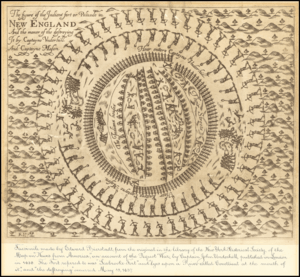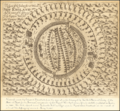Mystic massacre facts for kids
The Mystic massacre was a terrible event that happened on May 26, 1637. It took place during the Pequot War. This event is also known as the Pequot massacre or the Battle of Mystic Fort.
During the massacre, colonists from Connecticut Colony led by Captain John Mason attacked a Pequot Fort. They were joined by their Narragansett and Mohegan allies. The fort was near the Mystic River. The attackers set the wooden fort on fire. They killed many Pequot people who tried to escape. This was done to get back at the Pequots for earlier attacks. Between 400 and 700 Pequot people were killed. The only Pequot survivors were warriors who were away raiding with their leader, Sassacus.
Contents
Why the Conflict Started
The Pequots were a very strong Native American tribe in what is now southeastern Connecticut Colony. They often competed with the nearby Mohegan and Narragansett tribes.
Early European Trade
European colonists started trading with all three tribes. They traded European goods for wampum (shell beads) and furs. The Pequots became friends with the Dutch colonists. The Mohegans and other tribes allied with the New England colonists.
Rising Tensions and Attacks
Things got worse when a trader named John Oldham was killed. His trading ship was also robbed by Pequots. This led to attacks by the colonists and their Native American friends.
On April 23, 1637, about 200 Pequot warriors attacked the colonial village of Wethersfield. They killed six men and three women. These were people who were not fighting. This attack made the colonists very angry. It made more people support the war against the Pequots.
Also, a big storm in 1635 (the Great Colonial Hurricane of 1635) damaged corn and other crops. This made food scarce. This lack of food made the tensions between the Pequots and colonists even worse.
The Attack on the Fort
The towns in Connecticut gathered a group of soldiers called a militia. Captain John Mason led 90 of these men. He also had 70 Mohegan warriors led by their chiefs, Uncas and Wequash. Another 20 men joined them from Fort Saybrook, led by Captain John Underhill.
At the same time, the Pequot chief Sassacus took several hundred warriors. They planned another attack on Hartford, Connecticut.
March to the Fort
On their way to the Pequot Fort, Captain Mason's group grew even larger. More than 200 Narragansett and Niantic warriors joined them.
On the night of May 26, 1637, the colonial and Native American forces reached the Pequot village. The village was on a small hill near the Mystic River. It was a large village surrounded by a strong wooden fence called a palisade. There were only two ways to get in or out.
The Fire and the Fight
The attackers first tried a surprise attack, but the Pequots fought back hard. So, Captain Mason ordered the village to be set on fire. The two exits were blocked. As the fire grew, many Pequots tried to escape by climbing over the fence. They were shot as they tried. Those who did get out, including men, women, and children, were killed by the Narragansett fighters.
Captain John Underhill later described what happened. He said that Captain Mason set fire to one side of the fort. Underhill himself set fire to the other side with gunpowder. The fires met in the middle and burned very quickly. Many brave Pequots did not want to come out. They fought hard even as the fire burned their bows. Many people, including men, women, and children, were burned inside the fort. Others were forced out and met the soldiers. It was said that about 400 people were in the fort. Only about five of them escaped.
Mohegan warriors collected the heads of fallen Pequots. They also took scalps as war trophies. Hundreds of Pequots were killed. The colonists reported that only five villagers escaped, and seven were taken prisoner. This was one of the first times colonists used such a complete attack in the new world.
Pequot Counterattack
Pequot warriors who had been with their chief Sassacus returned and found the massacre. They chased after the colonial forces. But the Puritans managed to get away. They avoided any major counterattack, even though they got lost for a short time.
What Happened Next
Estimates say that between 400 and 700 Pequot people died. This included women, children, and older people. The colonists had fewer losses, with about 22 to 26 injured and two confirmed dead. About 40 Narragansett warriors were hurt because the colonists sometimes mistook them for Pequots.
The End of the Pequot Tribe
The massacre greatly weakened the Pequot tribe. Sassacus and many of his followers were later surrounded in a swamp. This battle is known as the "Fairfield Swamp Fight". Nearly 180 warriors were killed, wounded, or captured there. Sassacus escaped with about 80 men. However, he was later killed by the Mohawks. The Mohawks sent his scalp to the colonists as a sign of friendship.
The number of Pequots was so small that they almost stopped being a tribe. A treaty said that the remaining Pequots had to join the Mohegan and Narragansett tribes. They were not allowed to call themselves Pequots anymore. However, in the late 1900s, descendants of the Pequots brought the tribe back. They gained official recognition from the government in 1983.
Some Pequot women and children, possibly 500 to 1000, were sent away. They were taken on ships to places like Bermuda and Barbados.
How People See It Today
When the modern Pequot tribe became active again in the 1990s, people started discussing the Mystic massacre. They debated whether it should be called an act of genocide. Some authors and legal experts, like Dr. Rebecca Joyce Frey and Steven M. Wise, have called it genocide. Wise noted that Captain John Underhill said killing women and children was justified by religious texts.
Statues and Remembrance
In 2020, people called for the removal of a statue of Captain John Mason in Windsor, Connecticut. This happened during national discussions about historical statues. The statue was first put up at the site of the massacre in 1889. It was moved to Windsor in 1996 because it was where Mason lived. In September 2020, the town council voted to move the statue to the Windsor Historical Society. However, a director at the Pequot Museum, Dr. Kevin McBride, said that the Pequot tribal chairman had been against its removal in the 1990s. He believed that if the statue was taken down, people might forget what happened.
In early 2021, there were also calls to remove another statue of Captain John Mason. This one stands outside the Connecticut State Capitol in Hartford. After a year of talks, a state group decided the statue could stay. However, lawmakers can still discuss its future.
The Mystic massacre was also shown in the History Channel TV series 10 Days That Unexpectedly Changed America.
Images for kids





